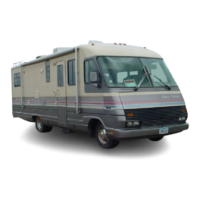32
Discovery, Discovery LXE, Pace Arrow, and Pace Arrow LXEt
Clean the oor and move
the driver and passenger
seats forward.
Retract the slideout
room(s).
CAUTION:
To extend or retract the
slideout room, the ignition
must be on, the engine
running and battery
voltage 13.0 volts. Apply
the park brake. Operate
the slideout room when
supported by hydraulic
jacks. Damage to
the slideout room,
mechanism or seals can
occur.
Secure and fasten all
interior doors. Lock the
shower door.
Close roof vents and
windows.
Secure all loose, heavy or
sharp objects in case of a
sudden stop.
Close all cabinet doors
and drawers.
Turn off interior lights.
Turn off the water pump.
Check fuel level and
all other gauges for
operation and correct level
indications.
Departure Checklist:
Secure items in storage
bays to prevent shifting or
damage of items.
Look around, above and
under the motorhome for
obstructions. Check for
debris stuck between the
rear dual tires.
Close and lock exterior
compartment doors.
Check operation of all
exterior lights, headlamp,
taillamp, brake and
clearance lights.
Secure all awning and
travel locks.
Ensure the jack pad is
clear of debris when
retracting hydraulic jacks.
Loose rocks, gravel and
debris can be thrown
from the jack pad and can
possibly damage the tow
car.
Secure and lock the entry
door for travel.
Pull forward out of the
campsite.
Inspect site for overlooked
items.
EMERGENCY
ROADSIDE
PROCEDURES
If an emergency
situation occurs,
use the appropriate
braking technique and pull off
the roadway a safe distance
from trafc (if possible). Set
the parking brake and turn on
the hazard warning ashers,
especially when parked alongside
trafc lanes. In the event of
an emergency stop due to a
mechanical breakdown or other
motorhome related problems,
contact customer support or an
emergency service provider.
Road ares or reective warning
signs should be displayed if the
motorhome is on the side of
the road for any length of time.
Guidelines for placing warning
triangles depend upon the road
characteristics and visibility. For
example: The standard placement
is 10, 100 and 200 ft. from the
rear of the motorhome when on
a divided highway or one-way
road. On a two-way road, with
trafc traveling both directions,
the same placement is required at
the front of the motorhome. Roads
with curves and hills may require
the placement of the last/farthest
triangle to be 500 ft. behind the
motorhome in order to safely warn
approaching trafc.
In Case of Flat Tire
In the event of a at tire, it is
recommended to call for roadside
assistance. The size and weight of
the motorhome and tires requires
heavy duty equipment to change
the tire. A professional service
technician will have the proper
equipment and training to repair
or replace the tire.
In case of sudden tire failure,
avoid heavy braking as this can
result in loss of control. Hold
the steering wheel rmly and
gradually decrease speed.
Slowly move to a safe off-road
place which should be a rm level
spot. Turn the ignition off and turn
the hazard ashers on.
WARNING:
DO NOT crawl under
the motorhome for any
reason if a wheel has been
removed. Any number
of circumstances could
cause the motorhome to
suddenly fall, resulting in
severe injury or death.
070175
020185b
Ensure jack
pad is clear of
debris.

